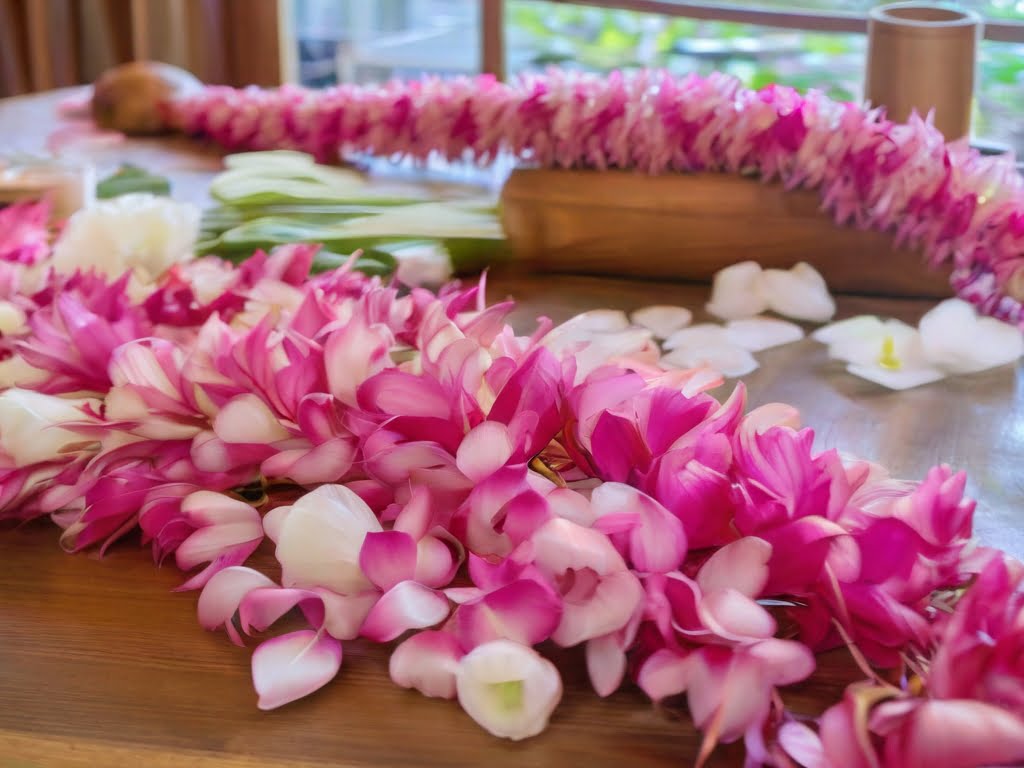Picture yourself on the stunning beaches of Hawaii, the sweet scent of exotic flowers filling the air as you lay in the sun. Have you ever wondered about the beautiful floral garlands that adorn the necks of locals and tourists alike? In this article, we will explore the art of lei making, unraveling its deep cultural significance and customs that have been passed down through generations. Join us as we dive into the vibrant world of Hawaii’s iconic floral garlands and learn the etiquette behind this cherished art form.
Table of Contents
ToggleThe History of Lei Making
The Origins of the Lei
Lei making has a long and rich history that is deeply intertwined with the culture and traditions of Hawaii. The origins of lei making can be traced back hundreds of years to the early Polynesians who settled on the islands. In ancient Hawaiian society, leis were not merely decorative adornments but held significant cultural and spiritual importance.
The Evolution of Lei Making
Over time, lei making evolved and adapted to the changing cultural landscape of Hawaii. The arrival of European and Asian influences in Hawaii brought new materials, techniques, and designs to the art of lei making. These new influences, combined with the traditional Hawaiian practices, resulted in a diverse and vibrant array of lei styles.
Traditional Hawaiian Lei Designs
Traditional Hawaiian leis were crafted using native materials, such as flowers, leaves, and shells. Popular flowers used in lei making include plumeria, pikake, and ilima. Each flower holds its own significance and symbolism, adding depth and meaning to the lei. Native leaves, such as ti leaves and ferns, were also commonly used in lei making.
Materials Used in Lei Making
Native Hawaiian Plants
Native Hawaiian plants have always been at the heart of lei making. The lush landscapes of Hawaii provide an abundance of natural materials that can be used to create beautiful and fragrant leis. Flowers like hibiscus, orchids, and maile are commonly used in lei making, each carrying its own unique symbolism and cultural significance.
Imported Flowers and Foliage
The arrival of different cultures in Hawaii introduced a wide range of imported flowers and foliage that quickly became popular in lei making. Flowers like roses, tulips, and carnations bring vibrant colors and new textures to lei designs. In addition, foliage from around the world, such as eucalyptus or ivy, can be incorporated into leis for added variety and visual appeal.
Alternative Materials
In recent years, lei makers have begun exploring alternative materials to create unique and non-traditional leis. From fabric and ribbons to feathers and seashells, the range of materials used in lei making has expanded to reflect the creative and innovative spirit of contemporary lei artists. These alternative materials allow for personalized and one-of-a-kind lei creations.
Tools and Techniques
Traditional Tools
Traditionally, lei making required minimal tools, as it was primarily done by hand. Scissors, needles, and thread were commonly used to thread flowers and foliage together to create intricate designs. The dexterity and skill of the lei maker were crucial in shaping and arranging the materials to form a visually pleasing and durable lei.
Modern Tools and Innovations
With advancements in technology, modern lei makers have access to a wider array of tools and equipment. Floral wire, hot glue guns, and floral adhesive have made the process of creating leis more efficient and precise. These tools allow for greater artistic freedom and the ability to work with a broader range of materials.
Step-by-Step Lei Making Process
The art of lei making typically involves several steps, each requiring attention to detail and creativity. The process begins by selecting the desired materials, whether it be flowers, leaves, or alternative materials. The chosen materials are then carefully prepared by removing excess foliage or thorns. Next, the lei maker uses their preferred technique, such as stringing, braiding, or weaving, to assemble the lei. The final step involves securing the ends and ensuring the lei is well-balanced and visually appealing.
Symbolism and Significance of Leis
Leis as Symbols of Aloha
Leis hold a deep symbolic significance in Hawaiian culture, representing love, respect, and hospitality. When a lei is given, it is a gesture of warmth and affection, an expression of aloha. The act of presenting and receiving a lei is accompanied by a kiss on the cheek or a hug, further reinforcing the bond between the giver and recipient. Wearing a lei is not only a visual representation of Hawaiian hospitality, but it also serves as a reminder of the values and traditions that make Hawaii so special.
Lei Etiquette and Giving
In Hawaii, there is a specific etiquette when it comes to giving and receiving leis. It is customary to present a lei with a warm smile and a genuine sense of aloha. When receiving a lei, it is important to graciously accept it and to wear it with pride and gratitude. It is considered disrespectful to remove or discard a lei in the presence of the person who gave it to you. Instead, it is customary to remove the lei privately, preserving it as a treasured keepsake.
Special Occasions and Lei Protocol
Leis are an integral part of various special occasions and celebrations in Hawaii. From birthdays and graduations to weddings and funerals, leis carry different meanings and protocols depending on the event. For example, on graduation day, it is customary for graduates to receive multiple leis as a symbol of their achievements. On the other hand, during a funeral, mourners might wear black kukui nut leis as a sign of respect for the deceased.
Different Types of Leis
Fresh Flower Leis
Fresh flower leis are the epitome of Hawaiian beauty and elegance. Crafted using a variety of flowers, such as plumeria, orchids, and ginger, these leis are known for their vibrant colors and delightful fragrance. Fresh flower leis are often given to welcome visitors, celebrate special occasions, or simply to brighten someone’s day. These leis are typically worn around the neck or draped over the shoulders, creating a stunning visual display.
Kukui Nut Leis
Kukui nut leis hold a special place in Hawaiian culture. The kukui tree, also known as the candlenut tree, is native to Hawaii and its nuts are traditionally polished and strung together to create beautiful and dark-hued leis. Kukui nut leis are often associated with protection and are considered a symbol of good luck. They can be worn by both men and women and are commonly given on significant occasions or as a gesture of appreciation.
Ti Leaf Leis
Ti leaf leis are made using the leaves of the ti plant, a popular native plant in Hawaii. The leaves are typically braided or woven together to form a lei that is both durable and visually striking. Ti leaf leis hold great cultural significance and are seen as a symbol of protection and good luck. These leafy leis are commonly given to honor guests, celebrate important events, or to symbolize the bond between individuals.
Feather Leis
Feather leis are a stunning and unique form of lei making. Traditionally crafted using the vibrant feathers of native Hawaiian birds, such as the ‘i’iwi or mamo, these leis are a testament to the skilled craftsmanship and creativity of the lei maker. Feather leis are considered a precious and valuable adornment and are often reserved for special occasions or as cherished heirlooms.
Shell Leis
Shell leis showcase the natural beauty of Hawaii’s coastal treasures. Made from an assortment of seashells, these leis are known for their iridescence and delicate craftsmanship. Shell leis can range from simple designs with a single type of shell to intricate patterns created by combining different types and sizes of shells. They are often worn as a statement piece, adding a touch of elegance and oceanic charm to any attire.
Candy Leis
Candy leis add a playful and delicious twist to the art of lei making. These leis are created by stringing individually wrapped candies onto a cord or ribbon, resulting in a colorful and edible lei. Candy leis are often given to children or as festive gifts during holidays and celebrations. They bring joy and excitement to the lei-making tradition and are a favorite among the young and the young at heart.
Lei Making Workshops and Classes
Learning the Art of Lei Making
For those interested in learning the art of lei making, there are various workshops and classes available both in Hawaii and online. These classes provide hands-on experience and guidance from skilled lei makers who share their knowledge and techniques. Participants have the opportunity to explore different materials, styles, and designs, allowing them to create personalized leis that reflect their own creativity.
Community Lei-Making Gatherings
Community lei-making gatherings are a beloved tradition in Hawaii, where people come together to create leis for special occasions or events. These gatherings offer an opportunity for individuals to learn from experienced lei makers and to participate in the cultural practice of lei making. The atmosphere is lively and festive, with laughter and camaraderie filling the air as lei makers work side by side, sharing stories and passing down their knowledge to the next generation.
Online Resources
In today’s digital age, there are numerous online resources available for those interested in lei making. Websites, blogs, and video tutorials offer step-by-step instructions, tips, and inspiration for creating beautiful leis. Online communities and forums provide a platform for lei makers to connect, share ideas, and seek advice. These online resources make lei making accessible to anyone, regardless of their geographical location.
Preserving and Caring for Leis
Proper Lei Preservation Techniques
Preserving a lei is essential to extend its lifespan and retain its beauty. Depending on the type of lei and materials used, there are various preservation techniques to ensure the lei remains fresh and vibrant for as long as possible. For fresh flower leis, misting with water, refrigeration, or using water-absorbing crystals can help maintain their freshness. Shell and candy leis require gentle handling and careful storage to prevent damage.
Displaying and Storing Leis
Leis are not only meant to be worn but can also be displayed as a beautiful reminder of special moments and cherished memories. There are several creative ways to showcase leis, such as hanging them on a wall or draping them around a picture frame. When storing leis, it is important to handle them gently and store them properly to prevent tangling or crushing. Some recommend placing the lei in a plastic bag with a damp paper towel to maintain moisture and freshness.
Revitalizing Wilted Leis
Even with the best preservation techniques, leis can naturally wilt over time. However, there are ways to revitalize wilted leis and bring them back to life. For fresh flower leis, soaking them in cold water or spraying with a mixture of water and floral preservative can help rejuvenate the flowers. Softening kukui nut leis with a bit of oil or polishing can restore their shine and luster. It is important to handle wilted leis with care to prevent any further damage.
Contemporary Lei Making Artists and Innovators
Prominent Lei Making Artists
Contemporary lei making has seen the emergence of talented artists who push the boundaries of traditional lei designs. These artists combine their creativity and technical skills to create innovative and stunning leis that captivate the imagination. Each artist brings their unique style and perspective to the art form, incorporating different materials, techniques, and cultural influences. Their work not only honors the traditions of lei making but also showcases the evolving nature of the art.
New Trends and Innovations in Lei Making
As with any art form, lei making continues to evolve and adapt to the changing times. New trends and innovations in lei making can be seen in the use of unconventional materials, experimentation with different techniques, and the fusion of cultural influences. Contemporary lei makers are also incorporating technology, such as 3D printing or LED lights, into their designs, resulting in leis that are visually striking and cutting edge.
Lei Making Across Cultures and Continents
Leis in Polynesian and Pacific Islander Cultures
While leis are synonymous with Hawaii, they are also an integral part of the culture in other Polynesian and Pacific Islander communities. In Tahiti, for example, flower leis known as ‘hei’ are worn for cultural events and celebrations. Similarly, in Samoa, lei-making traditions are deeply rooted in the culture and are often associated with important ceremonies and rituals. The art of lei making has woven its way across the Pacific, connecting cultures through a shared appreciation for beauty and symbolism.
Lei-Inspired Traditions Worldwide
The beauty and symbolism of leis have inspired similar traditions and practices in other parts of the world. In Asia, floral garlands are commonly used to honor deities in religious ceremonies or to celebrate festivals and weddings. In India, the exchange of floral garlands during weddings signifies the union of two souls. These lei-inspired traditions serve as a testament to the universal appeal and enduring significance of lei making as a symbol of love, respect, and joy.
Embracing Lei Making as a Cultural Practice
Honoring the Hawaiian Culture
For both locals and visitors, lei making offers a unique opportunity to embrace and honor the rich traditions and cultural heritage of Hawaii. By learning about the origins, symbolism, and techniques of lei making, individuals can deepen their connection to the land and its people. Engaging in the art of lei making fosters an appreciation for the intricate weaving of nature and culture that has been at the core of Hawaii’s identity for centuries.
Lei Making as a Creative Outlet
Lei making is not only a cultural practice but also a form of creative expression. Through the selection of materials, colors, and designs, lei makers are able to create unique and personalized works of art. The process of lei making allows individuals to tap into their creativity, explore their artistic instincts, and find joy in the act of creation. Lei making provides a creative outlet that can be both meditative and fulfilling.
Lei Making as a Form of Meditation
The rhythmic and repetitive nature of lei making lends itself to being a meditative practice. As one carefully strings each flower or leaf, there is a sense of mindfulness and presence in the moment. Lei making encourages a state of calm and tranquility, allowing the lei maker to find solace and peace within themselves. Engaging in this art form can be a way to cultivate inner stillness and foster a sense of harmony with the natural world.
Lei making is an art that intertwines nature, culture, and creativity. From the traditional techniques passed down through generations to the innovative designs of contemporary artists, leis continue to hold a special place in Hawaiian culture and beyond. Whether it’s the vibrant colors and fragrances of fresh flower leis or the timeless elegance of kukui nut leis, each lei carries a story and a connection to the rich tapestry of Hawaii’s history. So next time you receive or create a lei, take a moment to appreciate the artistry, symbolism, and aloha that it represents.





